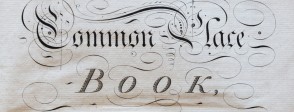Engage interest in Erasmus Darwin by asking students to analyse his portrait in For the classroom. What are students’ first impressions of Darwin? Show them a picture of Darwin’s house in Lichfield and give some interesting nuggets about Darwin’s family life, personality, education and work as a doctor. Then tell students about commonplace books, explaining how they reflected the interests of their writers. Based on their knowledge of Darwin, ask students to make good guesses about what subjects he might have included in his commonplace book and how many pages (out of 160 in total) he might have devoted to each subject. Then tell students the actual number of pages allocated to different subjects. What does this reveal about Darwin’s interests?
Show students the five inventions from the Commonplace Book in For the classroom. You could print copies of the images and challenge students to read Darwin’s handwriting and make sense of his drawings. Which inventions do students find most surprising? Which were just playful? Which were potentially most useful?
As an extension of this activity, students could role-play a meeting of the Lunar Society. In small groups, they could explain (in role as Darwin) one of Darwin’s inventions to the members of the Society who could then evaluate it. Emphasise that, as far as we know, the meetings were enjoyable and good humoured with members often joking and teasing each other. You could develop a version of the role play in which students researched different members of the Lunar Society. They could assume the role of the particular member and share their latest idea.
As well as being the starting point for investigating the ideas of the Lunar Men, Erasmus Darwin’s Commonplace Book could be integrated into enquiries focusing on wider developments in Britain’s history:
Who deserves a place in the Enlightenment Hall of Fame?
Following some of the specific activities based on Erasmus Darwin’s Commonplace Book, students could broaden their study by researching other Enlightenment thinkers and scientists. The enquiry could begin with members of the Lunar Society. As well as focusing on the scientific achievements of the Lunar Men, it would also be worth considering their social and political views. Several members, including Darwin, Wedgwood and Priestley, were active in the campaign against the slave trade and students could find out about their involvement through on-line research. Initially, the Lunar Men were positive about the French Revolution and this made them dangerous thinkers in some people’s minds. The Gillray cartoon in For the classroom, featuring Joseph Priestley holding an empty plate for the king’s head, provides an interesting starting point. The enquiry could range much wider than the Lunar Men to include the scientific and other achievements of the figures in A bigger picture.
Students could work in groups to research a particular individual and then make a presentation justifying why they should be included in the Enlightenment Hall of Fame. Students should focus on the significance of the individual’s work for our lives today. Only five people can be given a place. After listening to the presentations a panel of student judges can decide who will be included and a classroom display or digital Hall of Fame can be created.
When did toilets in Britain really change?
One of Erasmus Darwin’s inventions was an improved water closet. The notes next to his sketch read: ‘’there should be no valve at bottom, but a stink trap”. The problem of waste is one that has faced human beings for thousands of years; an enquiry into the changes in toilets, and more generally in public health, can reinforce chronological understanding and help students to develop a stronger sense of period. Without giving students any background information, ask them to work out what Erasmus Darwin was writing about on page 118 of his Commonplace Book. When they realise that this is a flushing toilet, give them more information on the problems of going to the toilet in 18th century Britain. You can then teach a thematic study on living conditions, toilets and public health through time, focusing on particular places at specific times, for example, the Neolithic settlement of Skara Brae, the latrines at Housesteads Fort, a medieval city, castle and monastery, 16th century town and country houses, an early industrial town and an Edwardian city. At the end of the enquiry students should reflect on the changing patterns in living conditions, toilets and public health. They could make an annotated graph to explain their thinking.
Why did the Industrial Revolution happen here?
Show students the clip in For the classroom of Pandemonium from the opening ceremony of the 2012 Olympics. Ask students to record their impressions of what they see and then discuss the creativity and power of Danny Boyle’s interpretation of the Industrial Revolution in Britain. Challenge students to answer the enquiry question. Students can consider a range of factors including population increase, cheap energy provided by coal, the intellectual creativity of the Lunar Society, the role of entrepreneurs such as Matthew Boulton and Josiah Wedgwood, the liberal economic and political climate in Britain, Britain’s transatlantic slave trade and the development of transport networks. Use a huge ball of string and get pupils caught up in ‘human causation web’ as they make connections between different factors. At the end of the enquiry students could write an essay to answer the enquiry question.


